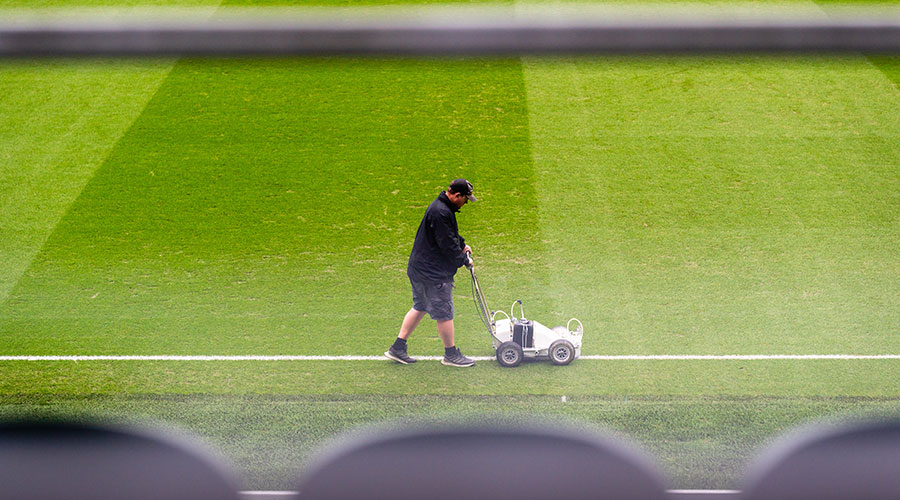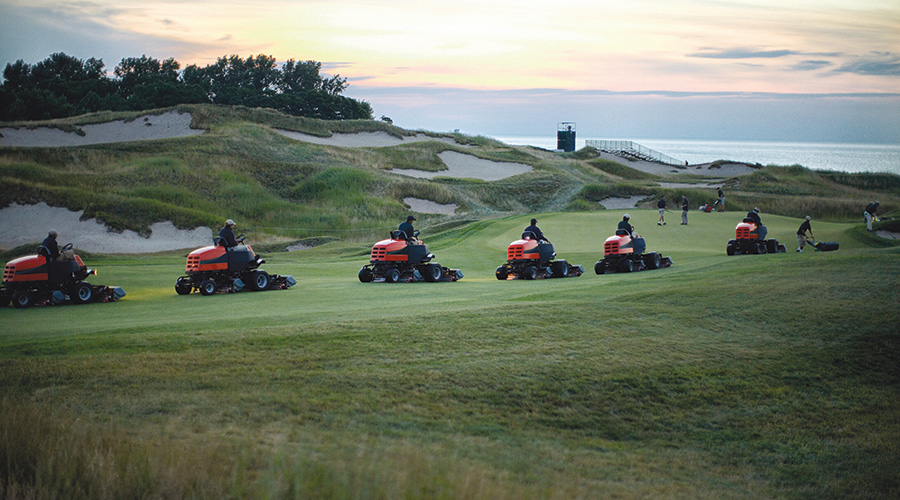Taking Control of Bothersome Birds
Rethinking management strategies and selecting from an array of deterrents can help protect occupants, buildings and landscapes
Grounds managers face many challenges with pests that damage the health and appearance of their landscapes. When some managers think of pest management in the landscape, they automatically think of controlling diseases, insects, weeds, and animals, including deer and moles. Birds usually are not considered major pests, but they can and do cause serious problems for people, plants and structures, and managers cannot afford to ignore their presence.
Health Considerations
Unlike most other landscape pests, birds and their droppings can carry diseases that cause illness and even death among humans. Among the more than 60 transmittable bird diseases are these:
• Histoplasmosis is a respiratory disease that humans can contract from accumulations of old bird droppings. The dangerous spores multiply in well-established or abandoned roosts, not fresh droppings. In some cases, the infection can result in flu-like symptoms, but if left untreated, it can become chronic and cause blindness, lung damage and even death.
• Cryptococcosis is caused by yeast found in the intestinal tract of pigeons and starlings. The illness often begins as a pulmonary disease and later can affect the central nervous system.
• St. Louis encephalitis is an inflammation of the nervous system and usually causes drowsiness, headaches and fever. It can even result in paralysis, coma and death. St. Louis encephalitis is especially fatal to people older than 60 but can occur at any age. The disease is spread by mosquitoes that have fed on infected birds.
• West Nile virus is not transmitted directly to humans from birds but rather from a mosquito that has bitten an infected bird.
Birds not only pose health risks to humans. They also can harm buildings, vehicles and landscapes. Fresh bird droppings can eat away at pavement, building materials and vehicle paint. Beyond that, bird nests can clog drain pipes, interfere with electrical services and fire escapes, and become fire hazards.
Early Action
Bird problems usually develop in stages. The first signs of bird activity often go unnoticed, so it is helpful to schedule regular inspections, especially in late winter, of all facilities and landscaped areas to look for the signs of roosting or nesting birds.
If birds are congregating in trees or on buildings or if inspectors notice accumulations of droppings, managers should implement control measures immediately. When control or bird-proofing measures begin at the first sign of trouble, it is easier to rid the area of the unwanted pests. But after birds have established themselves in an area, it is much harder to rout them out.
Avicides, which are used to kill problem birds, are not readily available because most products have been phased out of production. These chemicals are extremely toxic and should not be the first choice in controlling bird pests. If managers decide to use these chemicals, they should check with local and state authorities regarding licensing and permissible use.
It is possible to reduce or eliminate bird populations without toxic chemicals. The process begins with proper identification of the problem bird and learning its life cycle and habits. Determine what is attracting them to the site. The next step is to develop a plan that makes the area undesirable for the problem birds. Managers can use a combination of methods, including sound deterrents, visual devices and physical barriers.
Sounding the Alarm
A range of bird-deterrent techniques and products are available, and some work better than others. Experimenting with several combinations can help determine the best combination for a particular.
Set up speaker systems that broadcast predator-bird calls and distress calls at random times throughout the day. Choose a system that varies the frequency, duration and cycle of calls so birds to not get used to the same sound. Bottle rockets or other loud noise makers, such propane cannons, used at dusk will scare starlings and keep them from roosting in trees. Sound deterrents are useful in scaring pigeons, woodpecker, starlings and blackbirds.
Seeing is Believing
Visual deterrent devices can be effective on birds such as pigeons, starlings, blackbirds and woodpeckers. These devices include balloons with eyes, laser lights, water sprays, and fake snakes, alligators, and owls.
The best visual devices incorporate movement. For example, holograms appear to move when viewed from different angles, and fake predators mounted on springs or strings can move with the wind.
Iridescent bird-deterrent foil hung from rooftops, trees or fence posts changes color and reflects different patterns as they blow in the wind. The foil also makes an irritating noise that disturbs birds.
Getting Physical
Many facilities feature bird spikes, sticky caulk, wire coils and even electrified wires to keep birds from landing on roofs and ledges. Bird netting, hardware cloth and wire mesh are additional physical barriers designed to keep birds out of a given area.
Other options include a translucent, synthetic mesh that workers can drape over structures to keep the birds from accessing the ledges, window sills and other nooks and crannies where they congregate. This type of netting is barely visible and can be used in aesthetically sensitive areas.
Workers should monitor all types of bird-deterrent strategies regularly to make sure they are effective. None of the above solutions are one-time-only activities. Managers must employ them over a sufficient period of time to change the habits of the birds.
Focus on Geese
Today’s urban landscapes are especially attractive living spaces for Canada geese, which thrive in large, open spaces with mowed, fertilized lawns surrounding lakes or detention ponds. As a result of laws protecting these birds and the lack of natural predators, geese populations are booming.
The Canada goose can devastate a lawn. According to estimates, geese can eat up to 5 pounds of grass per day and produce up to 1½ pounds of droppings. Their continual grazing can compact turf areas and contaminate water supplies.
Barrier plantings around the water are the best answer to the deterrent question. Use native perennial flowers and grasses around the ponds. Geese instinctively perceive areas of taller, native wildflowers as unsafe environments where predators might be lurking. Native perennial wildflowers and grasses also have deep root systems that can help stabilize eroding shorelines. The cost to establish the wildflowers and grasses is usually lower than the cost of limestone rip rap.
When setting up a bird control plan, managers need to proceed cautiously. The Migratory Bird Treaty Act and the Endangered Species Act prohibit the trapping, possession and killing of most birds, their eggs and nests without a permit.
Managers who have problems positively identifying nuisance birds should consult bird authorities before attempting to control pests. Only house sparrows, starlings and pigeons are not protected by state or federal laws. But local ordinances might protect these birds, so check with local authorities before taking action.
Mower Selection: 5 Considerations
Before making purchasing decisions regarding mowing equipment, grounds managers should consider these five key issues in developing a specification strategy:
-
Ask mowing-equipment operators about their equipment preferences, including specific features that would make their jobs easier and make them more productive.
-
Ensure that operators test-drive each piece of equipment before purchase. Test the equipment on site to a get a better sense of how it reacts under specific conditions.
-
Review the size and terrain of areas to be mowed, taking into account any landscaping and site features that affect mowing. Choose a complement of mower sizes that will get the job done most efficiently. Newer, smaller mowers might actually produce a better quality cut more quickly than larger units, making the entire job less time-consuming.
-
Determine operators’ needs for transporting equipment. Does the mower or tractor in question fit on a trailer with other equipment? Will the department need a new trailer or new truck to pull the trailer and mower?
-
Consider off-season operations the mower could perform in the off-season. Are attachments available that could make the machine more useful year-round?
— Cathy Walker
|
Spotlight: GIE
The Green Industry & Equipment Expo (GIE) on Oct. 25-27 in Louisville, Ky., offers attendees access to makers of outdoor power equipment for professional and rental use. Products on display include lawn and garden products, as well as light-construction and landscape equipment.
About 125 of the show’s 650 exhibiting companies will supplement their indoor booths with three days of demos.
For more info, visit www.gie-expo.com.
|
Related Topics:











